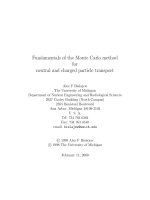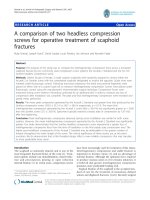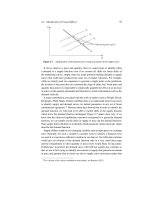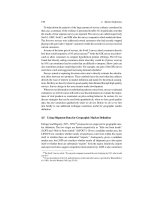Comparison of two different laparotomy techniques for ovariohysterectomy and post-surgical complications in cats
Bạn đang xem bản rút gọn của tài liệu. Xem và tải ngay bản đầy đủ của tài liệu tại đây (115.06 KB, 4 trang )
Int.J.Curr.Microbiol.App.Sci (2019) 8(5): 331-334
International Journal of Current Microbiology and Applied Sciences
ISSN: 2319-7706 Volume 8 Number 05 (2019)
Journal homepage:
Original Research Article
/>
Comparison of Two Different Laparotomy Techniques for
Ovariohysterectomy and Post-Surgical Complications in Cats
M. Babu1*, A. Krishnaswamy1, R. Nethra2 and Narasimhamurthy1
1
Department of Veterinary Gynaecology and Obstetrics, 2Department of Veterinary Medicine,
Veterinary College, Bengaluru, India
*Corresponding author
ABSTRACT
Keywords
Midline, Flank,
Ovariohysterectomy,
Cat
Article Info
Accepted:
04 April 2019
Available Online:
10 May 2019
Comparative study of two different laparotomy techniques and post surgical complications
for ovariohysterectomy in cats were studied. The animals were randomly divided into two
equal (n = 6) groups, A and B. In group A, ovariohysterectomy was performed by ventral
midline approach, where as in group B, ovariohysterectomy was performed by flank
approach. The duration of surgery, length of surgical incision, cost of surgery,
complications peri and post-operatively were compared. In cats subjected to
ovariohysterectomy through lateral flank approach had minimal hemorrhage at incisional
site. Further, the length of surgical incision, time required for the complete surgical
procedure, cost of the surgery and post operative healing complications were all
significantly lower in animals subjected to ovariohysterectomy through a lateral left flank
incision. It was concluded that the spaying through left lateral flank approach offers
considerably more advantages than a ventral midline approach.
along with the uterus of a female cat, to make
her disable to have any more conception.
Traditionally,
ovariohysterectomy
is
performed through a small ventral midline
incision in cats (Coe et al., 2006). However a
ventral midline approach is difficult to carry
out if surgery is performed shortly after
delivery due to the engorgement of mammary
glands and is also reportedly associated with
some postoperative complications such as
excessive hemorrhage from the skin and
subcutaneous tissue, wound inflammation or
infection and leakage from mammary tissue
(McGrath et al., 2004).
Introduction
Despite the status of cats as human
companions, a majority of cats in a
developing country like India are stray and
free roaming and constitutes a massive public
health hazard. Additionally, numerous stray
cats die from exposure, starvation or trauma
every year. Surgical sterilization of female
cats is the most opted technique by Veterinary
Surgeons as animal birth control.
Ovariohysterectomy in cats, also known as
spaying, is a surgical ablation of the ovaries
331
Int.J.Curr.Microbiol.App.Sci (2019) 8(5): 331-334
In view of these complications an alternate
approach, a unique lateral left flank surgical
approach has been suggested by Babu et al.,
(2018). However there are very few studies
which have made an attempt to compare the
ease of the approach to the uterus and
postoperative
complications
following
ovariohysterectomy through a ventral midline
and left lateral flank approach.
(2018). All animals were operated by a single
surgeon with good expertise in both the
surgical procedures. Length of surgical
incision, ease of locating and exteriorization
of uterus, ease of legating ovaries, time
required for the entire surgical procedure
were objectively measured and any
complications experienced during course of
surgery were also duly recorded. Finally at
the end of the surgery the cost of the surgery
was calculated based on consumption of
materials used for surgery such as syringes,
drugs, suture materials, surgical gloves,
dressing
material
and
miscellaneous
consumables. Following surgery, all the cats
belonging to group A and B were admitted as
inpatients and the incisional site was
examined at 6, 12, 24, 72 hours and 7 days to
evaluate the nature of wound healing and
record any complications associated with
wound healing.
Materials and Methods
Twelve healthy queen cats aged 1-3 years,
weighing 2.5 – 4 kg presented to Department
of Veterinary Gynaecology and Obstetrics,
Veterinary College Hospital, Hebbal,
Bangalore for ovariohysterectomy were
randomly selected for this study. The queen
cats selected were carefully examined to rule
out pregnancy and any uterine disorders and
for general health status and only queen cats
found fit with normal body parameters were
selected for surgery. The selected queen cats
were randomly allotted in equal numbers in
two groups. Group A consisted of six cats
which were subjected for ovariohysterectomy
by ventral mid line approach and Group B
consisted of six cats which were subjected for
ovariohysterectomy by flank approach.
Results and Discussion
The mean time for completion of entire
surgical procedure in Group A and Group B
were 12 ± 0.41 and 6.7 ± 0.48 minutes
respectively. Significantly higher mean time
was recorded in Group A compared to Group
B. The mean length of surgical incision for
both Group A and Group B were recorded as
1.5 ± 0.13 and 0.77 ± 0.06 cm, respectively.
The length of surgical incision was
significantly longer in Group A compared to
Group
B.
The
ease
of
locating,
exteriorization, ligation of ovaries was similar
between the two groups. Neither anaesthetic
nor the other surgical complications were
recorded during the study period. The mean
expenses incurred for surgery in Group A and
Group B were recorded as 160 ± 0.67 and
142.3 ± 0.89 rupees, respectively. The mean
surgical cost was significantly higher in
Group A compared to Group B. Four out of
six animals in group A exhibited varying
degree of oedema around the surgical site
The cats of both the groups were
premedicated with Atropine sulphate (0.04
mg/kg
body
weight)
subcutaneously.
Anesthesia was induced by combination of
Xylazine Hydrochloride (1 mg/kg body
weight) and Ketamine Hydrochloride (25
mg/kg body weight) both drugs were loaded
into the same syringe and had given
intramuscularly to effect.
Group A cats were subjected for
ovariohysterectomy by ventral mid line
approach according to Fingland (1998) and
Group B cats were subjected for
ovariohysterectomy through a small incision
left flank approach according to Babu et al.,
332
Int.J.Curr.Microbiol.App.Sci (2019) 8(5): 331-334
until 72 hours post surgery, while only one cat
developed oedema at surgical site group B.
Further, mild serosanguinous discharge
observed at surgical site in two out of six
animals in group A on 1st and 2nd day post
surgery. On the other hand, none of the cats in
group B showed any discharges. The time
taken for complete healing of surgical site
was much shorter with the left flank approach
as compared to the ventral midline approach
(7 days versus 11 days respectively).
encountered at the flank site in both
exteriorizing and legating the ovarian
peduncle and cervix.
Coe et al., (2006) reported that there was no
difference between the total duration of
surgery required for the two approaches. In
the present study, time required for the
completion of ovariohysterectomy through
the lateral flank approach was significantly
shorter as the ovaries were approached
through a stab incision through abdominal
muscles and following spaying, the stab
incision were left unsutured, thereby reducing
the time required for the surgery.
The primary aim of the present study was to
determine the surgical site which is most ideal
for carrying out ovariohysterectomy in cats.
Wilson and Balasubramanian, (1967) reported
significant haemorrhage from the incisional
site when ovariohysterectomy attempted
through flank region. In the present study on
the other hand, ovariohysterectomy was
attempted through a stab puncture rather than
an incision on abdominal muscle and such an
approach was found to result in almost
negligible haemorrhage at the surgical site.
Ghanawanth and Mantri (1996) observed that
exteriorizing opposite ovary and uterine horn
was difficult from flank approach. In the
present study, however, no difficulty was
Kiani et al., (2014) reported time taken for
lateral flank was significantly less compare to
midline approach, 24.50±1.48 and 28.33±0.92
respectively. Coe et al., (2006) observed that
the duration of operation through flank was
41±12 min and it was 43±11min for cats
operated through midline approach. Though
the above findings are in accordance with our
study the total mean time taken for both the
approaches are less in present study. This
would be attributed to expertise of the
surgeon in performing the surgery (Table 1).
Table.1 Different parameter analysed to compare two ovariohysterectomy approaches
Parameters
Time taken (min)
Length of surgical incision (cm)
Ease of locating and exteriorisation of uterus
Ease of legation of ovarian peduncle and cervix
Cost of surgery (Rs.)
It was also observed that spaying through a
left flank incision resulted in fewer post
operative complications such as wound
oedema and abnormal discharges from the
incisional site as compared to cats spayed
through a ventral midline incision. The fewer
complications observed in cats spayed
through a stab incision a left flank approach is
Ventral Midline
12 ± 0.41a
1.50 ± 0.13a
3.80 ± 0.60
2.80 ± 0.31
160.00 ± 0.67
Left flank
6.7 ± 0.48b
0.77 ± 0.06b
2.30 ± 0.42
2.00 ± 0.26
142.30 ± 0.89
probably due to minimal surgical exposure
site, minimal trauma to the abdominal
muscles, minimal handling of the tissues and
the shorter time for completion of the surgical
procedure. Another significant advantage of
spaying a cat through a left flank stab
incisional approach was the significantly
lower expenses incurred towards the surgery
333
Int.J.Curr.Microbiol.App.Sci (2019) 8(5): 331-334
as compared to the ventral midline approach
(142.3 ± 0.89 vs 160 ± 0.67). Further cats
subjected to spaying through a left flank stab
incisional approach had a significantly a
shorter interval from surgery to complete
wound healing. Present study findings are in
accordance with Kiani et al., (2014), have
reported 14.50±0.89 and 10.67±1.15 days for
complete wound healing in ventral midline
and lateral flank method respectively.
A. H. and Holt, P. E. 2006. Comparison
of flank and midline approaches to the
ovariohysterectomy of cats. Vet. Rec.
159: 309-313.
Fingland, R. B., 1998. The Uterus. In Current
techniques in small animal surgery. 4th
edn. Eds M. J. Bojrab, G. W. Ellison, B.
Slocum Baltimore, Williams & Wilkins.
pp-489–510.
Ghanawat, H.G. and Mantri, M.B., 1996.
Comparative
study
of
various
approaches for ovariohysterectomy in
cats. Ind. Vet. J., 73: 987-988.
Kiani, F.A., Kachiwal, A.B., Shah, M.G.,
Nizamani, Z.A., Khand, F.M., Lochi,
G.M., Haseeb, A., Khokhar, A.M., Oad,
A. and Ansari, M.I., 2014. Comparative
study on midline and flank approaches
for ovariohystrectomy in cats. Journal
of Agriculture and Food Technology,
4(2), pp.21-31.
McGrath, H., Hardie, R. J. and Davis, E.,
2004. Lateral flank approach for
ovariohysterectomy in small animals.
Compend Contin Educ Small Anim
Pract., 26: 922–930.
Wilson, F. D. and Balasubramanium, N.N.
1967. The lateral approach for the
spaying of canines and felines. Ind. Vet.
J. 44: 1052–1055.
A significantly lower cost incurred for
surgery, minimal post operative complications
and faster wound healing in animals subjected
to spaying through a left flank stab incisional
approach are extremely advantageous when
stray cats as most of such procedures in stray
cats are carried out by non-governmental
agencies which looking out at trying to reduce
the cost of surgery and duration of post
operative confinement of the animal.
References
Babu, M., Krishnaswamy, A., Nethra, R. and
Narasimhamurthy. 2018. A Simple
Technique for Ovariohysterectomy in
the Cat. Int.J.Curr.Microbiol.App.Sci.
7(8): 2554-2561.
Coe, R. J., Grint, N. J., Tivers, M. S., Moore,
How to cite this article:
Babu, M., A. Krishnaswamy, R. Nethra and Narasimhamurthy. 2019. Comparison of Two
Different Laparotomy Techniques for Ovariohysterectomy and Post Surgical Complications in
Cats. Int.J.Curr.Microbiol.App.Sci. 8(05): 331-334.
doi: />
334









